Taxonomy
Family: Siricidae
Subfamily: Siricinae
Genus: Sirex Linnaeus, 1760
Species: Sirex mexicanus Smith, 2012
Common names: none
Background
Sirex mexicanus is a somewhat rare species from Mexico (Schiff et al. 2012Schiff et al. 2012:
Schiff NM, Goulet H, Smith DR, Boudreault C, Wilson AD, and Scheffler BE. 2012. Siricidae (Hymenoptera: Symphyta: Siricoidea) of the Western Hemisphere. Canadian Journal of Arthropod Identification 21: 1-305.).
Diagnostic characteristics
See Sirex for genus-level diagnostic characteristics.
Females:
- hind femurfemur:
the third segment of the leg between the trochanter and the tibia
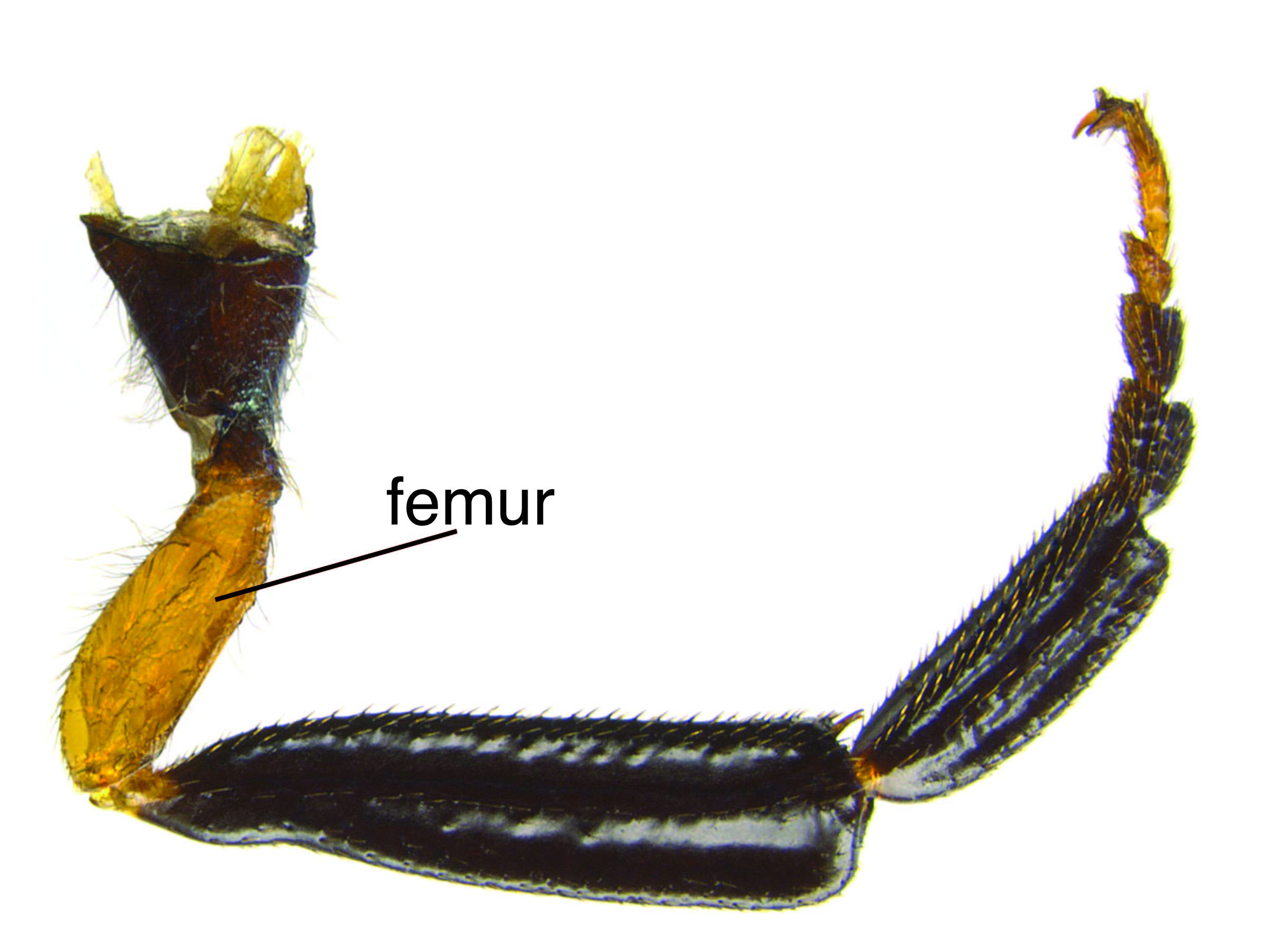 black (Schiff et al. 2012Schiff et al. 2012:
black (Schiff et al. 2012Schiff et al. 2012:
Schiff NM, Goulet H, Smith DR, Boudreault C, Wilson AD, and Scheffler BE. 2012. Siricidae (Hymenoptera: Symphyta: Siricoidea) of the Western Hemisphere. Canadian Journal of Arthropod Identification 21: 1-305.)
- abdomen abdomen:
the third and last segment of an insect's body; in sawflies this is usually made up of 11 segments (segments 9 and 10 often fused)
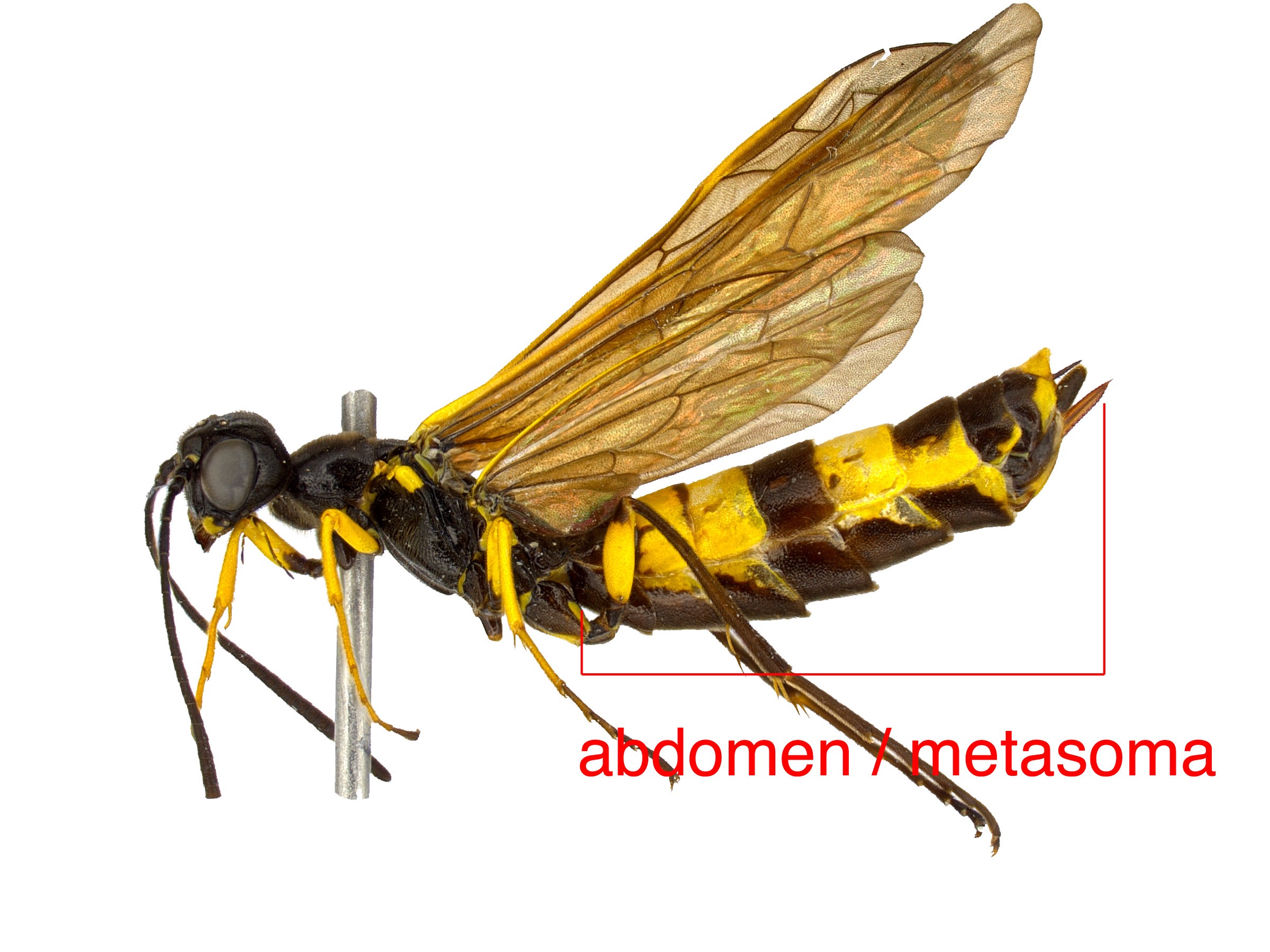 entirely black with metallic reflections (Schiff et al. 2012Schiff et al. 2012:
entirely black with metallic reflections (Schiff et al. 2012Schiff et al. 2012:
Schiff NM, Goulet H, Smith DR, Boudreault C, Wilson AD, and Scheffler BE. 2012. Siricidae (Hymenoptera: Symphyta: Siricoidea) of the Western Hemisphere. Canadian Journal of Arthropod Identification 21: 1-305.)
- all tibiaetibia:
the fourth segment of the leg, between the femur and the tarsus
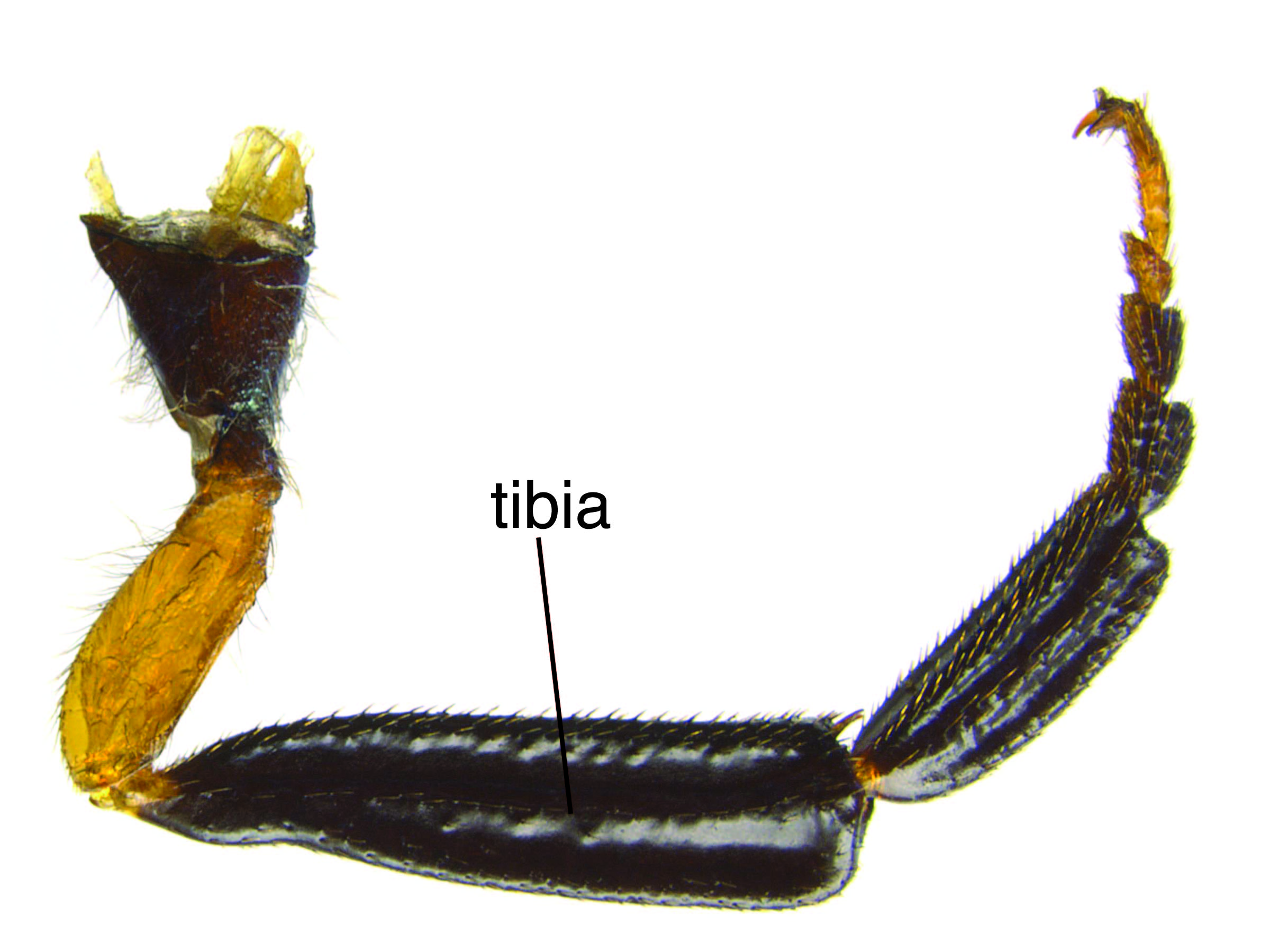 and tarsitarsus:
and tarsitarsus:
the fifth and last segment of the leg
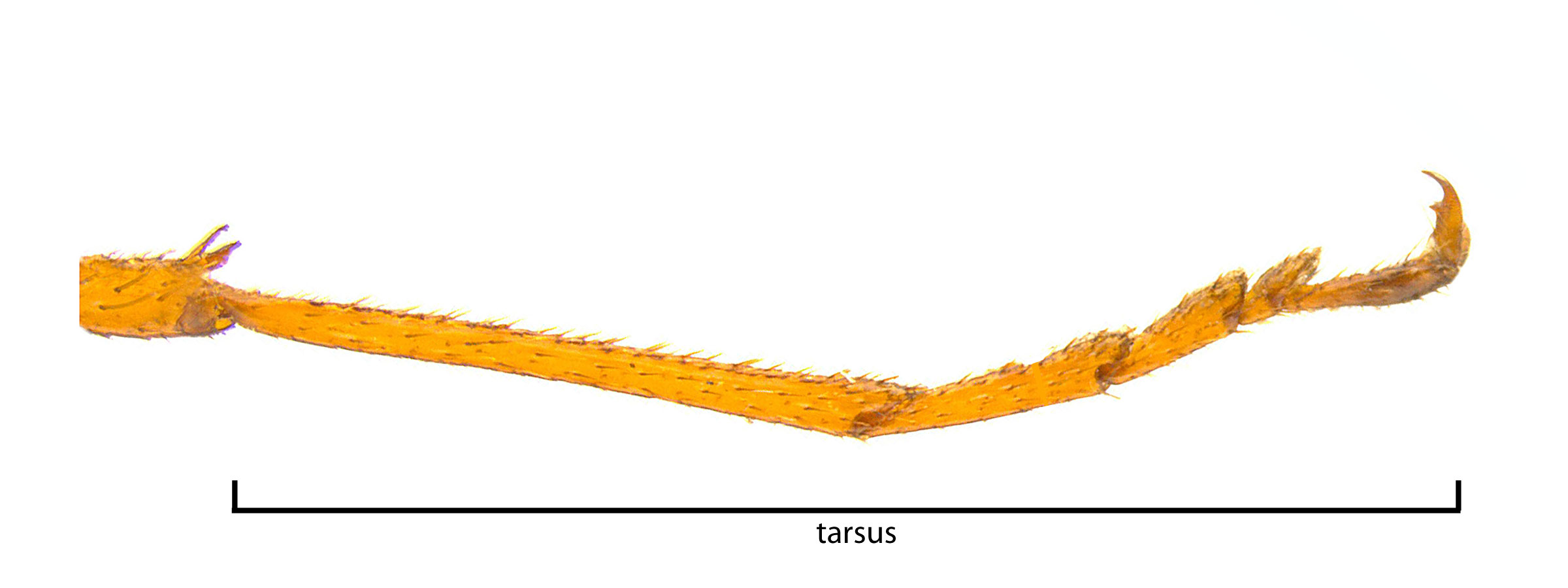 black (Schiff et al. 2012Schiff et al. 2012:
black (Schiff et al. 2012Schiff et al. 2012:
Schiff NM, Goulet H, Smith DR, Boudreault C, Wilson AD, and Scheffler BE. 2012. Siricidae (Hymenoptera: Symphyta: Siricoidea) of the Western Hemisphere. Canadian Journal of Arthropod Identification 21: 1-305.)
- fore wing fore wing:
the anterior wing of each pair of wings; usually the largest wing of the pair
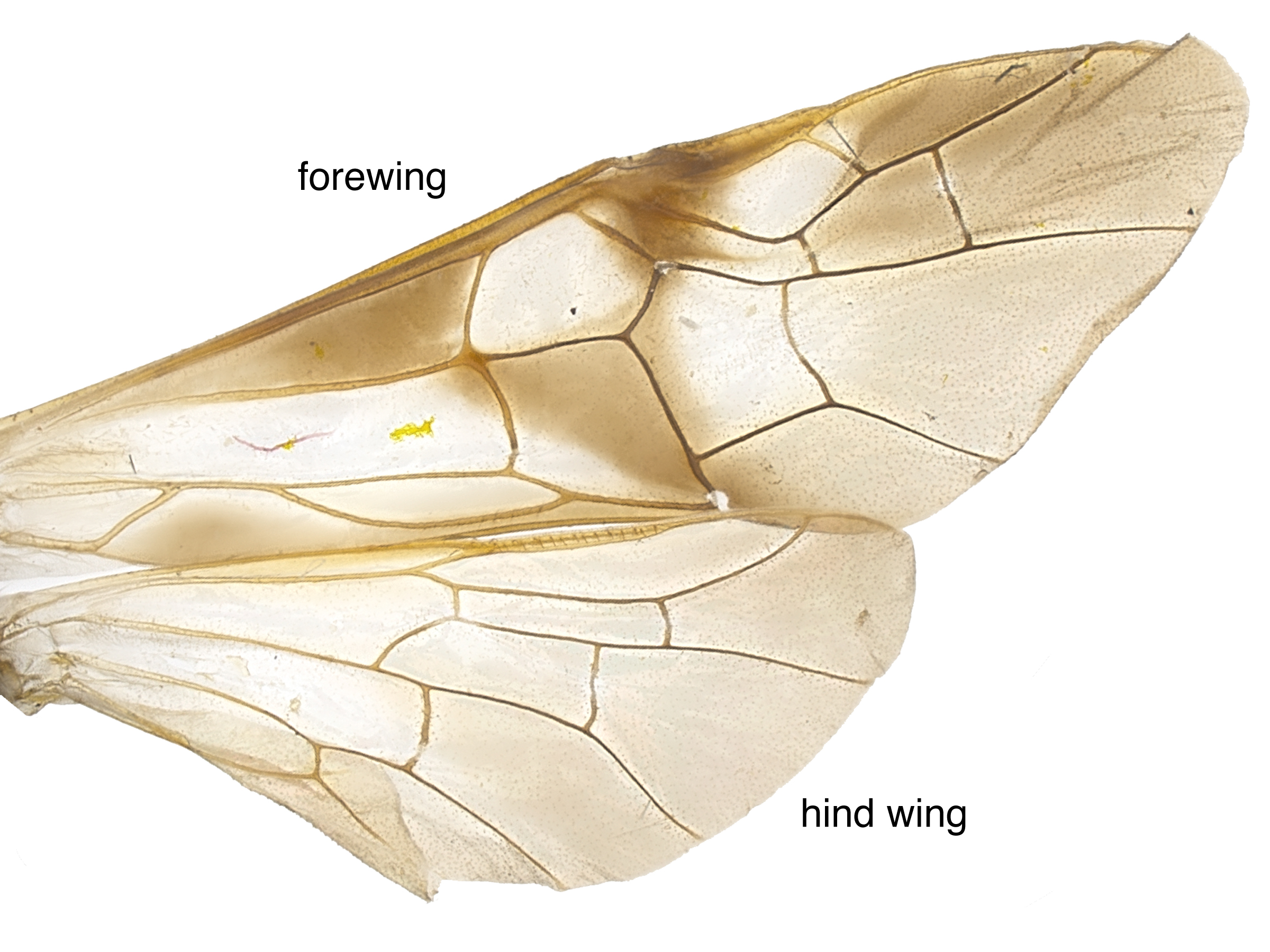 vein 3A present (Schiff et al. 2012Schiff et al. 2012:
vein 3A present (Schiff et al. 2012Schiff et al. 2012:
Schiff NM, Goulet H, Smith DR, Boudreault C, Wilson AD, and Scheffler BE. 2012. Siricidae (Hymenoptera: Symphyta: Siricoidea) of the Western Hemisphere. Canadian Journal of Arthropod Identification 21: 1-305.)
- gena gena:
the area of the head between the compound eye and clypeus; also called the cheek
 pits dense, about 0–0.5 pit diameters apart (Schiff et al. 2012Schiff et al. 2012:
pits dense, about 0–0.5 pit diameters apart (Schiff et al. 2012Schiff et al. 2012:
Schiff NM, Goulet H, Smith DR, Boudreault C, Wilson AD, and Scheffler BE. 2012. Siricidae (Hymenoptera: Symphyta: Siricoidea) of the Western Hemisphere. Canadian Journal of Arthropod Identification 21: 1-305.)
- vertex vertex:
the dorsal portion of the head between the compound eyes, between the occiput and frons
pits dense, about 0–0.5 diameter of laterallateral:
of or towards the side of the body
ocellus (Schiff et al. 2012Schiff et al. 2012:
Schiff NM, Goulet H, Smith DR, Boudreault C, Wilson AD, and Scheffler BE. 2012. Siricidae (Hymenoptera: Symphyta: Siricoidea) of the Western Hemisphere. Canadian Journal of Arthropod Identification 21: 1-305.)
- second hind tarsomeretarsomere:
a segment of the tarsus
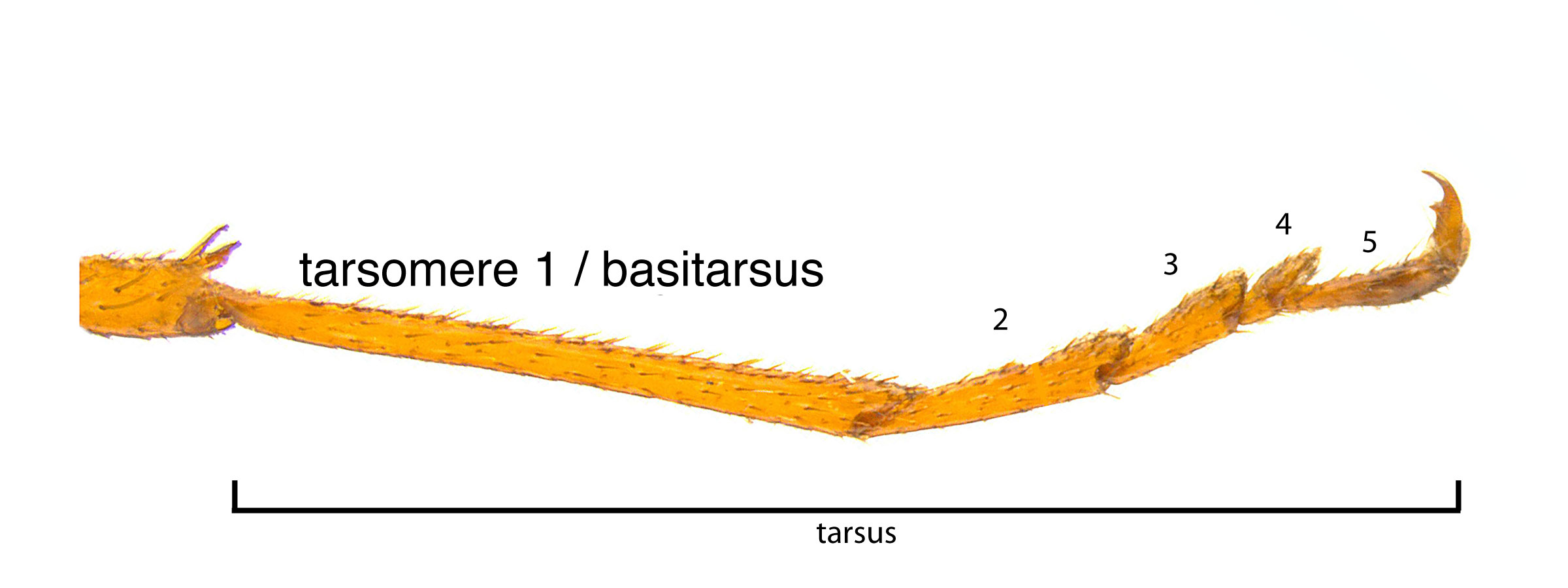 1.5–3.5 times as long as wide (Schiff et al. 2012Schiff et al. 2012:
1.5–3.5 times as long as wide (Schiff et al. 2012Schiff et al. 2012:
Schiff NM, Goulet H, Smith DR, Boudreault C, Wilson AD, and Scheffler BE. 2012. Siricidae (Hymenoptera: Symphyta: Siricoidea) of the Western Hemisphere. Canadian Journal of Arthropod Identification 21: 1-305.)
- mesoscutum mesoscutum:
the central and dorsal portion of the thorax between the scutellum and postnotum
 pits large, forming a few transverse ridges (Schiff et al. 2012Schiff et al. 2012:
pits large, forming a few transverse ridges (Schiff et al. 2012Schiff et al. 2012:
Schiff NM, Goulet H, Smith DR, Boudreault C, Wilson AD, and Scheffler BE. 2012. Siricidae (Hymenoptera: Symphyta: Siricoidea) of the Western Hemisphere. Canadian Journal of Arthropod Identification 21: 1-305.)
- second hind tarsomeretarsomere:
a segment of the tarsus
 with pulvilluspulvillus:
with pulvilluspulvillus:
soft pads used for surface adhesion, located in sawflies on the first 4 segments of the tarsus
 about half length of tarsomeretarsomere:
about half length of tarsomeretarsomere:
a segment of the tarsus
 (Schiff et al. 2012Schiff et al. 2012:
(Schiff et al. 2012Schiff et al. 2012:
Schiff NM, Goulet H, Smith DR, Boudreault C, Wilson AD, and Scheffler BE. 2012. Siricidae (Hymenoptera: Symphyta: Siricoidea) of the Western Hemisphere. Canadian Journal of Arthropod Identification 21: 1-305.)
Males:
- hind femurfemur:
the third segment of the leg between the trochanter and the tibia
 and coxacoxa:
and coxacoxa:
the first and most basal segment of the leg
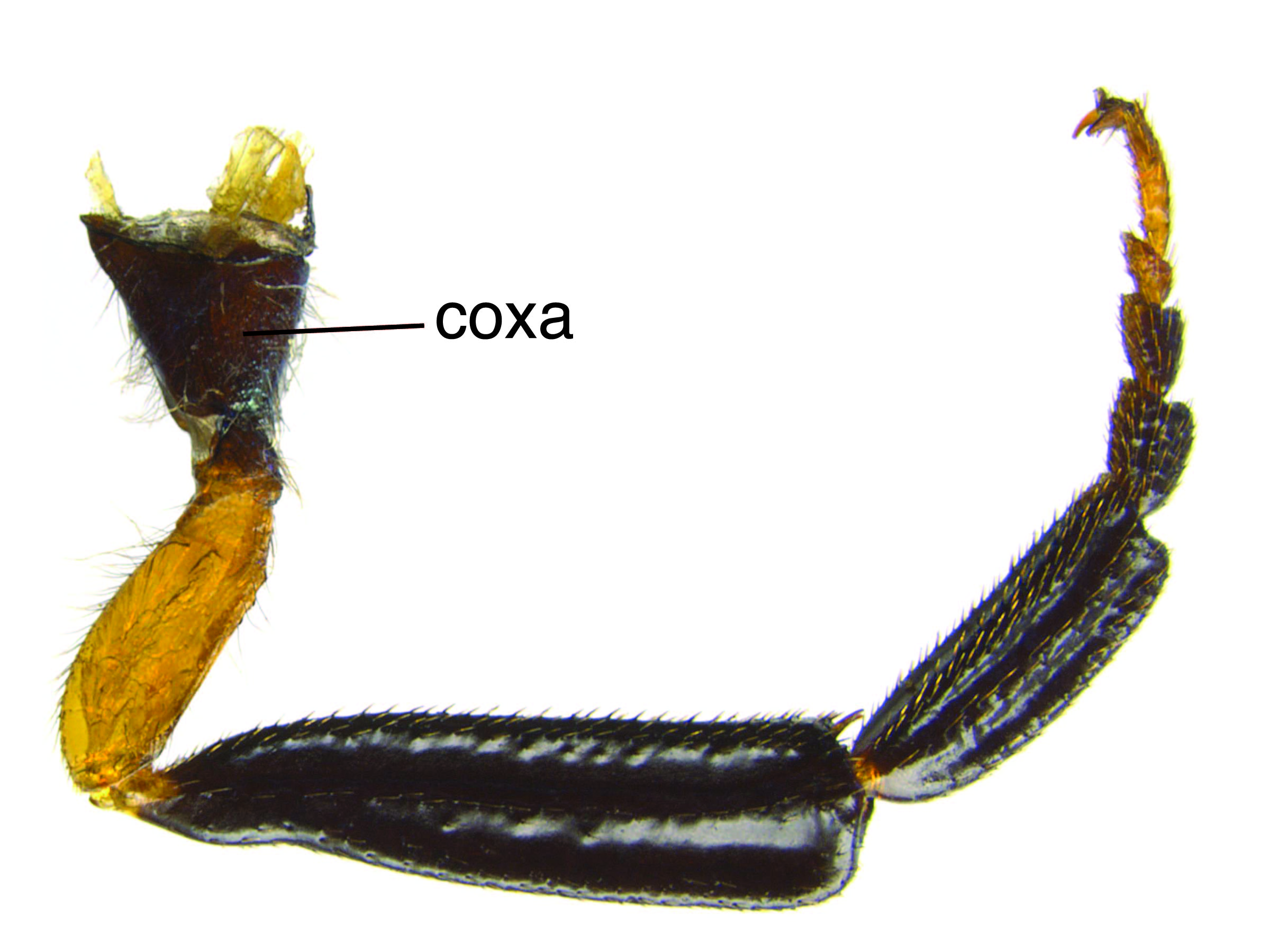 mostly reddish-brown (Schiff et al. 2012Schiff et al. 2012:
mostly reddish-brown (Schiff et al. 2012Schiff et al. 2012:
Schiff NM, Goulet H, Smith DR, Boudreault C, Wilson AD, and Scheffler BE. 2012. Siricidae (Hymenoptera: Symphyta: Siricoidea) of the Western Hemisphere. Canadian Journal of Arthropod Identification 21: 1-305.)
- gena gena:
the area of the head between the compound eye and clypeus; also called the cheek
 completely blue-black with metallic reflections (Schiff et al. 2012Schiff et al. 2012:
completely blue-black with metallic reflections (Schiff et al. 2012Schiff et al. 2012:
Schiff NM, Goulet H, Smith DR, Boudreault C, Wilson AD, and Scheffler BE. 2012. Siricidae (Hymenoptera: Symphyta: Siricoidea) of the Western Hemisphere. Canadian Journal of Arthropod Identification 21: 1-305.)
- hind tibiatibia:
the fourth segment of the leg, between the femur and the tarsus
 reddish-brown with dark band at the basebase:
reddish-brown with dark band at the basebase:
the beginning or most proximal area of any structure
(Schiff et al. 2012Schiff et al. 2012:
Schiff NM, Goulet H, Smith DR, Boudreault C, Wilson AD, and Scheffler BE. 2012. Siricidae (Hymenoptera: Symphyta: Siricoidea) of the Western Hemisphere. Canadian Journal of Arthropod Identification 21: 1-305.)
- gena gena:
the area of the head between the compound eye and clypeus; also called the cheek
 pits dense, about 1 diameter apart (Schiff et al. 2012Schiff et al. 2012:
pits dense, about 1 diameter apart (Schiff et al. 2012Schiff et al. 2012:
Schiff NM, Goulet H, Smith DR, Boudreault C, Wilson AD, and Scheffler BE. 2012. Siricidae (Hymenoptera: Symphyta: Siricoidea) of the Western Hemisphere. Canadian Journal of Arthropod Identification 21: 1-305.)
- fore wing fore wing:
the anterior wing of each pair of wings; usually the largest wing of the pair
 hyaline (Schiff et al. 2012Schiff et al. 2012:
hyaline (Schiff et al. 2012Schiff et al. 2012:
Schiff NM, Goulet H, Smith DR, Boudreault C, Wilson AD, and Scheffler BE. 2012. Siricidae (Hymenoptera: Symphyta: Siricoidea) of the Western Hemisphere. Canadian Journal of Arthropod Identification 21: 1-305.)
- antennae completely or almost completely reddish-brown (Schiff et al. 2012Schiff et al. 2012:
Schiff NM, Goulet H, Smith DR, Boudreault C, Wilson AD, and Scheffler BE. 2012. Siricidae (Hymenoptera: Symphyta: Siricoidea) of the Western Hemisphere. Canadian Journal of Arthropod Identification 21: 1-305.)
May be confused with
Sirex mexicanus females can be distinguished from S. xerophilus by the transverse ridges on the posterior half of the mesoscutummesoscutum:
the central and dorsal portion of the thorax between the scutellum and postnotum
 . The males can be recognized by the light colored antennaeantenna:
. The males can be recognized by the light colored antennaeantenna:
the sensory organ emerging from the front of the head, usually between the compound eyes and above the clypeus; includes the flagellum, scape and pedicel
 , coxaecoxa:
, coxaecoxa:
the first and most basal segment of the leg
 , and clear fore wingfore wing:
, and clear fore wingfore wing:
the anterior wing of each pair of wings; usually the largest wing of the pair
 (Schiff et al. 2012Schiff et al. 2012:
(Schiff et al. 2012Schiff et al. 2012:
Schiff NM, Goulet H, Smith DR, Boudreault C, Wilson AD, and Scheffler BE. 2012. Siricidae (Hymenoptera: Symphyta: Siricoidea) of the Western Hemisphere. Canadian Journal of Arthropod Identification 21: 1-305.).
Morphological and geographical variation
none recorded
Host associations
unknown
Life history
Female Sirex harbor symbiotic basidiomycete fungus in abdominal glands called mycangia. During oviposition, the site is inoculated with the fungus, which begins to decompose the surrounding wood. LarvaeLarva:
the immature stage of holometabolous insects
 feed on the fungus, and in the process bore galleries through the wood (Johnson 1930Johnson 1930:
feed on the fungus, and in the process bore galleries through the wood (Johnson 1930Johnson 1930:
Johnson CW. 1930. On the variation and abundance of Sirex nitidus Harris. Psyche 37 (3): 281-282. https://doi.org/10.1155/1930/62786, Schiff et al. 2012Schiff et al. 2012:
Schiff NM, Goulet H, Smith DR, Boudreault C, Wilson AD, and Scheffler BE. 2012. Siricidae (Hymenoptera: Symphyta: Siricoidea) of the Western Hemisphere. Canadian Journal of Arthropod Identification 21: 1-305.).
Larvae are creamy white and grub-like in appearance with a dark head capsule. As with adults, larvaelarva:
the immature stage of holometabolous insects
 possess a short dorsaldorsal:
possess a short dorsaldorsal:
of or on the top surface of the body or structure
horn on the posterior end of the body. The larvaelarva:
the immature stage of holometabolous insects
 bore galleries into wood, feeding until pupation and subsequent emergence. Throughout this process, the larvaelarva:
bore galleries into wood, feeding until pupation and subsequent emergence. Throughout this process, the larvaelarva:
the immature stage of holometabolous insects
 use their horn to pack the tunnel behind them with sawdust. Emergence holes are perfectly circular. The fungal symbiont is carried in specialized organs in female larvaelarva:
use their horn to pack the tunnel behind them with sawdust. Emergence holes are perfectly circular. The fungal symbiont is carried in specialized organs in female larvaelarva:
the immature stage of holometabolous insects
 that develop into the mycangia after metamorphosis (Schiff et al. 2012Schiff et al. 2012:
that develop into the mycangia after metamorphosis (Schiff et al. 2012Schiff et al. 2012:
Schiff NM, Goulet H, Smith DR, Boudreault C, Wilson AD, and Scheffler BE. 2012. Siricidae (Hymenoptera: Symphyta: Siricoidea) of the Western Hemisphere. Canadian Journal of Arthropod Identification 21: 1-305.).
The few existing specimens of S. mexicanus were collected in mid-June and mid-July (Schiff et al. 2012Schiff et al. 2012:
Schiff NM, Goulet H, Smith DR, Boudreault C, Wilson AD, and Scheffler BE. 2012. Siricidae (Hymenoptera: Symphyta: Siricoidea) of the Western Hemisphere. Canadian Journal of Arthropod Identification 21: 1-305.).
Distribution
World: North America
North America: Sirex mexicanus is only known from Mexico City and northern Mexico (Schiff et al. 2012Schiff et al. 2012:
Schiff NM, Goulet H, Smith DR, Boudreault C, Wilson AD, and Scheffler BE. 2012. Siricidae (Hymenoptera: Symphyta: Siricoidea) of the Western Hemisphere. Canadian Journal of Arthropod Identification 21: 1-305.).
No specific locality data was available for mapping the range of this species at the time of publication.
Host plant list
View full screen host table here
 black (Schiff et al. 2012Schiff et al. 2012:
black (Schiff et al. 2012Schiff et al. 2012: entirely black with metallic reflections (Schiff et al. 2012Schiff et al. 2012:
entirely black with metallic reflections (Schiff et al. 2012Schiff et al. 2012: and tarsitarsus:
and tarsitarsus: black (Schiff et al. 2012Schiff et al. 2012:
black (Schiff et al. 2012Schiff et al. 2012: vein 3A present (Schiff et al. 2012Schiff et al. 2012:
vein 3A present (Schiff et al. 2012Schiff et al. 2012: pits dense, about 0–0.5 pit diameters apart (Schiff et al. 2012Schiff et al. 2012:
pits dense, about 0–0.5 pit diameters apart (Schiff et al. 2012Schiff et al. 2012: 1.5–3.5 times as long as wide (Schiff et al. 2012Schiff et al. 2012:
1.5–3.5 times as long as wide (Schiff et al. 2012Schiff et al. 2012: pits large, forming a few transverse ridges (Schiff et al. 2012Schiff et al. 2012:
pits large, forming a few transverse ridges (Schiff et al. 2012Schiff et al. 2012: with pulvilluspulvillus:
with pulvilluspulvillus: about half length of tarsomeretarsomere:
about half length of tarsomeretarsomere: (Schiff et al. 2012Schiff et al. 2012:
(Schiff et al. 2012Schiff et al. 2012: and coxacoxa:
and coxacoxa: mostly reddish-brown (Schiff et al. 2012Schiff et al. 2012:
mostly reddish-brown (Schiff et al. 2012Schiff et al. 2012: completely blue-black with metallic reflections (Schiff et al. 2012Schiff et al. 2012:
completely blue-black with metallic reflections (Schiff et al. 2012Schiff et al. 2012: reddish-brown with dark band at the basebase:
reddish-brown with dark band at the basebase: pits dense, about 1 diameter apart (Schiff et al. 2012Schiff et al. 2012:
pits dense, about 1 diameter apart (Schiff et al. 2012Schiff et al. 2012: hyaline (Schiff et al. 2012Schiff et al. 2012:
hyaline (Schiff et al. 2012Schiff et al. 2012: . The males can be recognized by the light colored antennaeantenna:
. The males can be recognized by the light colored antennaeantenna: , coxaecoxa:
, coxaecoxa: , and clear fore wingfore wing:
, and clear fore wingfore wing: (Schiff et al. 2012Schiff et al. 2012:
(Schiff et al. 2012Schiff et al. 2012: feed on the fungus, and in the process bore galleries through the wood (Johnson 1930Johnson 1930:
feed on the fungus, and in the process bore galleries through the wood (Johnson 1930Johnson 1930: possess a short dorsaldorsal:
possess a short dorsaldorsal: bore galleries into wood, feeding until pupation and subsequent emergence. Throughout this process, the larvaelarva:
bore galleries into wood, feeding until pupation and subsequent emergence. Throughout this process, the larvaelarva: use their horn to pack the tunnel behind them with sawdust. Emergence holes are perfectly circular. The fungal symbiont is carried in specialized organs in female larvaelarva:
use their horn to pack the tunnel behind them with sawdust. Emergence holes are perfectly circular. The fungal symbiont is carried in specialized organs in female larvaelarva: that develop into the mycangia after metamorphosis (Schiff et al. 2012Schiff et al. 2012:
that develop into the mycangia after metamorphosis (Schiff et al. 2012Schiff et al. 2012: